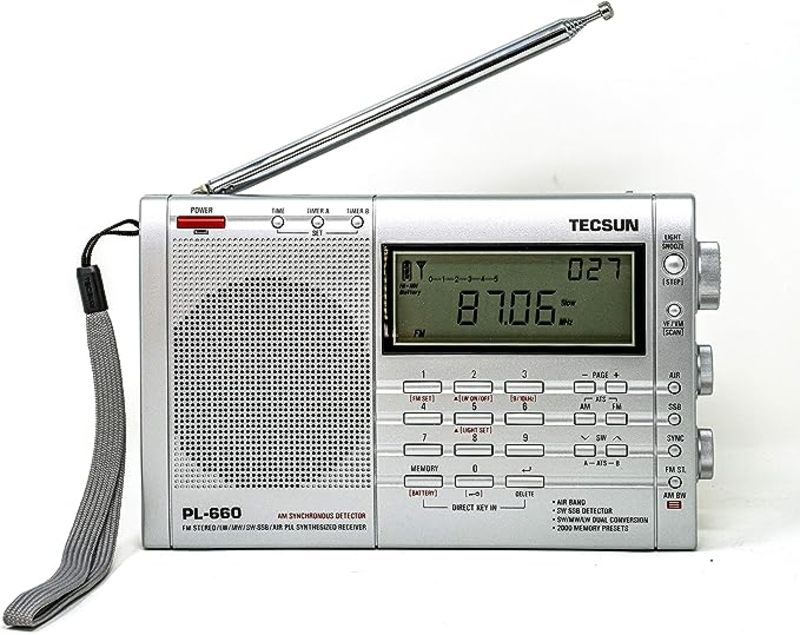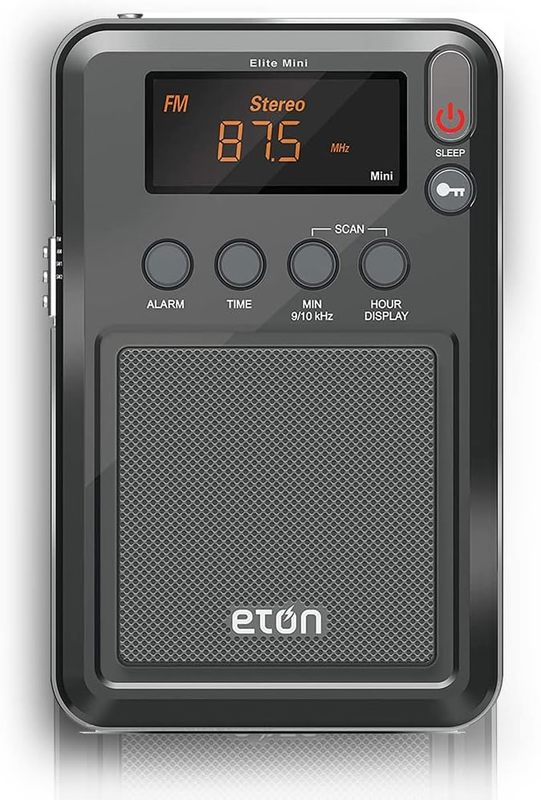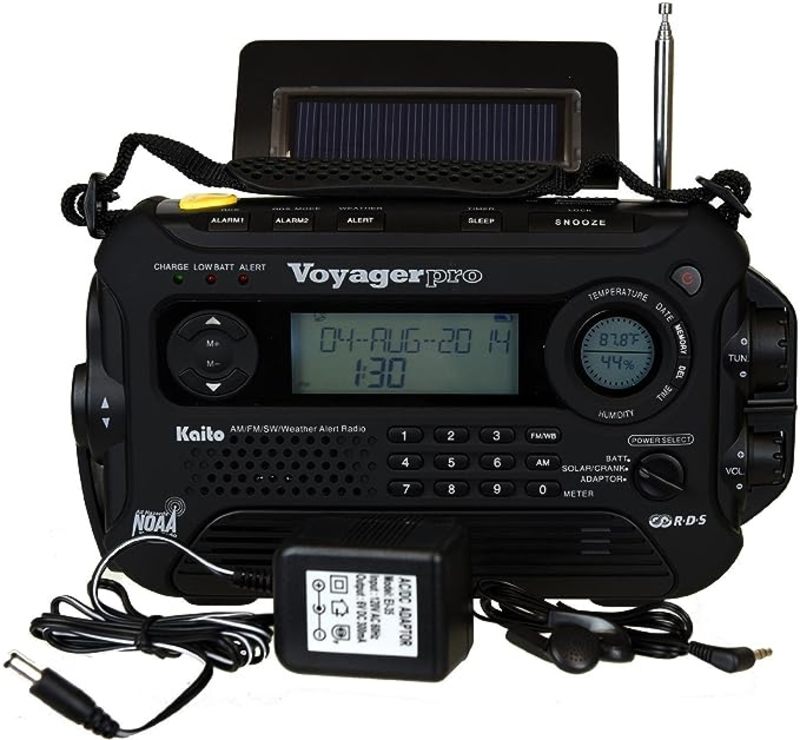The Best Shortwave Radios for Your Money
Radios remain one of our most reliable means of communication. This is why they’re a must-have item in emergencies, when the internet and power may be down, and why they're still used by military and law enforcement.
You probably listen to some local AM/FM stations for the news, the latest hits or your favorite broadcaster. However, there’s a lot beyond those frequencies — or, more accurately, right in between.
We’re referring to shortwave radio, which can open listeners up to worlds that are obscure, fun and far off the mainstream. Among the options you can tune in on shortwave radio include music and news from other countries, strange political propaganda and broadcasts from random amateurs (well, random licensed HAM operators) attempting to make contact with each other.
1. Best overall: Tecsun PL-880 Digital Shortwave Radio
2. Best value: VONDIOR Emergency Hand-Cranking Weather Radio
3. Best overall runner-up: Eton Elite Executive Digital Shortwave Radio
4. Editor’s pick: Tecsun PL-660 Digital Shortwave Radio
5. Best for low prices: Eton Elite Mini Compact Portable Shortwave Radio
6. Best emergency radio with shortwave: Kaito Voyager Pro KA600 Emergency Radio
What Is Shortwave Radio?
Shortwave radio consists of frequencies between 1710kHz and 30000kHz (30MHz). It’s called shortwave because, quite literally, the waves emitted are short as opposed to long waves and medium waves, used by AM radio, and wideband VHF (very high frequency) used by FM radio. These short waves can travel thousands of miles across the globe, so shortwave radio is, by nature, international.
It was widely used during the 20th century when virtually every country had several stations broadcasting via shortwave to the international public. Some of these are still operational, such as the BBC World Service, Voice of America and Radio France Internationale, among many others. It's also used by political and religious groups to inform international followers or avoid censorship in certain countries. And it’s used in emergency situations due to its incredible reach, even in places without antennas or electricity.
This is why you’ll also find a lot of “utility” content on shortwave radio. Through shortwave frequencies, you can hear military, aircraft and marine communications, and even morse code and alleged spy channels where you’ll hear random numbers and codes. It can all be cryptic, really, but definitely intriguing.
There's a big community dedicated to shortwave listening (SWL), so you'll find a lot of information, updates and interesting facts online, including where and how to find the most interesting — or creepiest — stations out there.
Shortwave Radio Buying Guide
Buying shortwave receivers isn’t as simple as picking up a regular AM/FM radio. Shortwave models require some additional components and considerations to be able to read and process shortwave frequencies.
Here are some important factors to understand before you purchase a shortwave radio:
• Analog or digital. Just like with regular radios, you’ll find both digital and analog options that can detect shortwave frequencies. There are noticeable differences between the two.
Modern digital shortwave radios have advanced components that filter and process signals better and reproduce higher-quality audio. They can also feature single sideband (explained below), while analog radios can’t.
Digital radios are also more convenient for the user. They have keypads where you can enter a frequency directly instead of finding it through the knob, save your favorite frequencies, are often rechargeable and can pack more features in a smaller unit.
Analog radios have a few advantages of their own. Although you can find high-end analog radios, they’re usually much less expensive, costing as little as $10. They're also available in many stores, especially during hurricane season.
Their layout can be very convenient for beginners because it’s a complete visual representation of the frequencies, and you see the thin red line traveling through them as you tune.
Finally, they provide a different experience while using them, just like any old analog radio; the difficult and imprecise manual tuning can also be part of the charm.
• Frequency range. The range of frequencies a radio can detect is one of the most important factors when looking at shortwave radios. Shortwave goes from about 1,710kHz (or 1.7MHz) to 30,000kHz (30MHz). Inexpensive radios under $50 range from about 2.3MHz to 21MHz, more or less. High-end radios are able to access the full range.
However, even with more expensive digital radios, you won’t be able to tune that precisely between those frequencies. Many radios tune in 10kHz increments, from 2.3MHz to 2.4MHz, for example. This is even harder on analog radios.
The best radios can fine-tune down to 0.01kHz, or 10Hz, so they can go, for example, from 2375.18 to 2375.19 with extreme precision. This opens up a lot more channels and opportunities to select the most accurate frequency possible for greater audio quality.
• Sensitivity. This is a radio’s ability to read weak signals. The higher the sensitivity, the more signals it’ll be able to pick up, and the sound will be clearer and more reliable.
However, too much sensitivity can lead to detecting some other signals, resulting in “outside” noise. Some users don’t mind it, though, as they’d rather have a stable signal with some noise than an interrupted one. Unfortunately, there isn’t a precise way to know a radio’s sensitivity without trying it out or reading in-depth reviews and hearing tests online.
• Selectivity. Selectivity is a receiver’s ability to focus on the frequency chosen by the listener and avoid interference from other “nearby” frequencies. When buying a radio, look for the bandwidth filter options. You can choose larger (wider) bands to increase the information the radio receives; this is particularly good for music, which has multiple sound frequencies.
The smaller (narrower) you go, the better it is to listen to a single voice and eliminate other surrounding noises. If you go super narrow, say 0.5kHz, you’ll only hear things like Morse code. The more bandwidth options, the better selectivity, resulting in accurate signal detection.
• Single sideband (SSB). Single-sideband modulation is highly complex but important to understand if you want to choose the right receiver. Basically, SSB modulation removes redundant information from the signal in order to make it more efficient. This results in a cleaner signal with less noise and interference; because of this, it can also use narrower bandwidths to reduce noise even more, so voices can be picked up and reproduced more faithfully.
SSB is heavily used in two-way communication by amateur HAM radio operators and in marine applications. Using it opens up more frequency possibilities because broadcasters can use the Lower Sideband (LSB) or Upper Sideband (USB), thus eliminating the “other side” of the signal, which carries essentially the same information. You can often hear two different broadcasts on the same frequency when changing from LSB to USB on your radio — note, however, that not all radios can change between these at the user’s will.
This modulation is complex, and requires more advanced technology, making receivers with this feature more expensive. It does, however, provide clearer and more intelligible audio. If you want a complete shortwave experience so you can listen to amateur broadcasters and communications from around the world, it’s worth the cost.
• Overall convenience. Other than the more technical stuff, you should consider features that make a radio fit your specific needs or interests.
First, portability. Although most radios on this list are on the smaller side, some are far easier to carry than others (the 4" x 6" Eton Elite Mini, for example). On the other hand, powerful models are large and heavy and some actually require to be plugged in all the time. It's good to keep that in mind if you value portability over a wider reach.
Another factor to consider: batteries and whether they’re rechargeable. Many radios still use regular AA batteries, while others use 18650 lithium-ion batteries that can be recharged via micro or mini USB. Unfortunately, models that use USB type C are currently in short supply.
Finally, the speakers. When talking about clarity and audio quality on a shortwave listening radio, it’s not always referring to the actual speaker, but to the signal; it’s important to look up video reviews before buying, which can help you get a sense of just how good the sound is.
Reviewing the Finest Shortwave Radios of 2023
1. Best overall: Tecsun PL-880 Digital Shortwave Radio
List Price: $199.99
Check on Amazon | Check on Walmart
Tecsun is one of the better-known brands in shortwave radios and one of the few that still consistently produces shortwave-capable radios. Among all their portable offerings, the PL-880 is widely regarded by the SWL (Shortwave Listening) community as, simply put, the best.
In fact, the PL-880 is said to have set the standard in the market for high-quality shortwave radios, especially at its price point. At about $190, it tops pricier competitors in terms of sensitivity — detecting weak signals — and selectivity.
The PL-880 has some of the clearest audio in its class. While it's not the most sensitive (though it can improve once you turn on the dynamic noise reduction feature, labeled as DNR), it does have a wide selection of bandwidth filters, making it the top choice for selectivity under $200.
In AM mode, filtering can range from 2.3kHz to 9.0kHz to find the best audio quality. As you go lower, you’ll pass through fewer frequencies. So you can go narrow when listening to voice broadcasts and eliminate surrounding sounds; when listening to music, use a wider one to appreciate all sounds.
When turning on single sideband (SSB) mode, it can go as low as 0.5kHz (or 500Hz) up to 4kHz. SSB signals transmit less overall information, so you can go lower than 2.3kHz for less signal interference without losing as much sound information through the filtered frequencies. However, a bandwidth as low as 0.5kHz is almost exclusively for Morse code since other sound frequencies, including voice, don’t make it through.
This model is also popular due to its very precise tuning. It can go as low as 10Hz intervals, so you can find the most specific frequency possible. The tuning is very smooth and jumps from frequency to frequency without muting, just like analog radios. (Many digital competitors mute briefly while changing frequencies.)
Finally, the PL-880’s frequency range goes from 100kHz to 108MHz (108,000kHz). Along with fine-tuning, this radio has access to a truly immense amount of frequencies. One of its downsides, however, is that it can’t go above 108MHz, so it has no access to VHF (very high frequencies) aircraft bands.
Pros
- Numerous memory locations for storing frequencies
- Main buttons are within easy reach
- Battery life lasts a week with frequent use
- Sturdy and well-built design
Cons
- Many options may be overwhelming for beginners
- Zipper case only holds radio, not accessories
2. Best value: VONDIOR Emergency Hand-Cranking Weather Radio
List Price: $35.99
Check on Amazon
The VONDIOR Emergency Hand-Cranking Weather Radio is a reliable companion in times of crisis and uncertainty. This multifunctional device is designed to keep you informed, connected, and powered up when traditional sources of electricity or communication are unavailable. It features AM/FM radio reception and NOAA weather alerts. That way, you can stay updated on the latest news, weather forecasts, and emergency information when you need it most.
As a product with the added convenience of a built-in flashlight and a power bank, this emergency radio serves as an all-in-one tool for your emergency preparedness needs. What sets it apart from the competition is its self-sufficiency. Equipped with both hand-cranking and solar charging capabilities, you can recharge this device anytime and anywhere. All you have to do is crank the handle to generate power or leave it outside to solar charge in the sun.
Pros
- Versatile device that serves multiple purposes
- Hand-cranking and solar-charging features
- Compact and portable design
Cons
- May have limited features
3. Best overall runner-up: Eton Elite Executive Digital Shortwave Radio
List Price: $149.99
Check on Amazon | Check on Walmart
The Eton Elite Executive competes directly with the PL-880 in the category of high-quality shortwave radios. While they're both very good options with similar capabilities, the Eton is currently listed at around $150.
The Eton tops the Tecsun in sensitivity and in the availability of aircraft bands between 118 and 136MHz (the Tecsun stops at 108MHz). However, the PL-880’s layout is more user-friendly, and the tuning is smoother (the Eton has a stepped wheel and mutes while changing frequencies, making the user stop to listen to each one).
Nevertheless, if you don’t mind paying more for higher sensitivity and for the opportunity to listen in on aircraft bands, you can’t go wrong with this model.
Pros
- Two BNC and wire connections for AM long wire
- Telescopic antenna fully rotates 360 degrees
- Speaker has volume, bass and treble controls
- Numbered keypad for exact frequency entry
Cons
- No noise-canceling or noise-blanking features
- Susceptible to RFI interference
4. Editor’s pick: Tecsun PL-660 Digital Shortwave Radio
List Price: $149.99
Check on Amazon | Check on Walmart
Tecsun radios are a go-to for shortwave listening. They can get expensive, however, especially when looking for models that have SSB modulation to rid signals of their extra weight and listen in on amateur radio broadcasters. At $150, the PL-660 is a great deal, especially for a shortwave capable radio that delivers on SSB.
In addition to a decent price and SSB, the PL-660 shines when it comes to sensitivity. It’s considered one of the top models in this regard; this sensitivity is also well-balanced, as the PL-660 has very little noise floor (interfering noise from other signals, which can increase with higher sensitivity).
It doesn’t have as many bandwidth choices as the PL-880 (it only has the two general options of wideband and narrowband), but the PL-660 reaches higher frequencies. This means you can listen to VHF aircraft bands between 118 to 137MHz.
Pros
- Sensitive with built-in whip antenna
- Scan feature to easily find active stations
- Single sideband capabilities provide clear speech
- Small, lightweight size and comfortable buttons
Cons
- Sound sometimes distorts on FM
- User manual may be difficult to understand
5. Best for low prices: Eton Elite Mini Compact Portable Shortwave Radio
List Price: $49.99
Check on Amazon | Check on Lowe's
Digital shortwave listening radios tend to be quite a bit more expensive than their analog counterparts. However, with digital models, you get very precise tuning, memory modes to save your favorite frequencies and a variety of technology to process radio signals better.
But some digital shortwave listening radios are very affordable, and the Eton Elite Mini Compact is a perfect example.
For under $50, you get a quality radio with access to a decent range of frequencies. You’ll notice, however, that when going down in price you’ll sacrifice SSB mode, fine-tuning and access to many frequencies between long wave, medium wave, short wave and VHF. On shortwave, the Elite Mini only reaches from 5.9MHz to 18MHz. You won’t be able to listen to anything from 18MHz to 87MHz. It does reach the 87MHz-108MHz FM frequencies, though, and has a full range of AM, from 520kHz to 1710kHz.
You won't be able to change bandwidths or focus your signal, but the Elite Mini’s sensitivity is very good for its small size and low price. For a casual listener who likes to have a quality radio in their backpack, you can’t go wrong with this Eton.
Pros
- Thin and compact design
- Good AM and FM reception
- Alarm and sleep features
- Premium leather case for portability
Cons
- LCD display can’t be seen when in case
- No memory presets for easily changing stations
6. Best emergency radio with shortwave: Kaito Voyager Pro KA600 Emergency Radio
List Price: $99.99
Check on Amazon | Check on Walmart
If you want a multipurpose radio to use during natural disasters and other emergencies, you’ll need an “emergency radio” with access to National Oceanic and Atmospheric Administration (NOAA) channels. Kaito is one of the most prominent names in that specific market, and it’s also known for making shortwave radios. The Voyager Pro KA600 delivers on both fronts.
Like most emergency radios, the KA600 can be powered by various methods: three regular AA batteries, plugged in via an AC/DC power adapter, through its built-in rechargeable battery (which can also be charged with a hand crank) or by means of a small solar panel on the back. It also has temperature and humidity information and a flashlight. Plus, it can be used as an external battery bank for other devices.
Nonetheless, the important feature here is the shortwave capability. It offers a really good shortwave range of 2.3MHz to 23MHz, especially given its very reasonable $70 price tag. It has full range on AM (520kHz-1710kHz) and FM (87MHz-108MHz), and preset access to all seven NOAA weather channels from 162.4MHz to 162.55MHz, the most important feature on emergency radios.
Since it’s not a dedicated shortwave receiver, you won’t be able to fine-tune. (In some higher-end models, you’ll get 10kHz increments, as opposed to 1kHz or even 0.01kHz.) And you won’t be able to choose different bandwidths for more precise selectivity. Despite the slight drawbacks, the KA600 is a great multipurpose solution for emergencies so you can stay informed, safe and even entertained. With its far-reaching shortwave capabilities, you’ll be able to access the information you need, even if nearby stations and antennas are down.
Pros
- Can be powered in three ways
- Has an alert function for severe weather
- Includes a flashlight with adjustable brightness
- Provides precise tuning with frequency dial
Cons
- On/off switch is inconveniently located
- Many buttons make it complicated to use
Why Trust Us
Our commitment to the consumer begins with product selection and ends with the last word we write in each article. Each shortwave radio is carefully vetted quantitatively through star ratings and the number of reviews and qualitatively through careful examination of reviews and the features each one has to offer. Leveraging our team of bargain hunters, we’re also always sure to keep your budget in mind while we find the best shortwave radios on the market. Our team of experts is dedicated to accurately depicting the pros and cons of each shortwave radio, translating technical product specifications into information you can understand. We aim to deliver the finest shortwave radio listening experience you can get for your hard-earned money.
More From Money:
The Best Generators for Your Money
The Best Patio Heaters for Your Money, According To Home Improvement Pros






